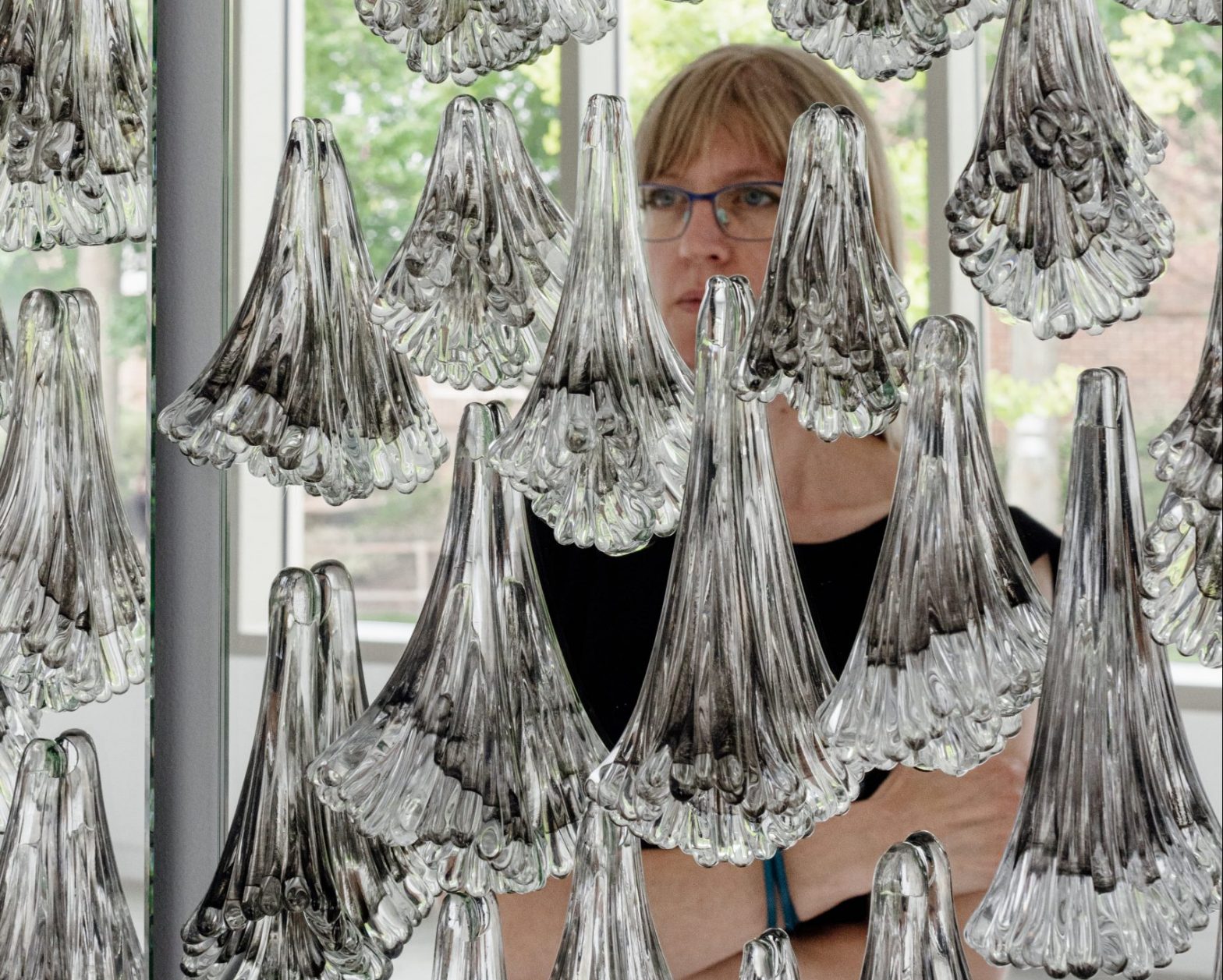Coral reefs are wondrous marvels of natural beauty. They are both living things and ecosystems for a myriad assortment of other creatures, and are a vital link in the chain of life. It’s estimated that 1 billion people benefit from coral reefs in the form of food, coastal protection, clean sea water, and income from tourism and fishing.
With “House on Fire” at Quirk Gallery, Kiara Pelissier uses glass to draw attention to the existential threat the earth and all its inhabitants are facing as our climate changes and temperatures rise. Pelissier focuses on the devastation happening to coral reefs around the globe. These beautiful animals are struggling to survive in an environment that is becoming untenable. Mass bleaching events, unknown until the 1980s, are now common occurrences in our oceans, which absorb 93 percent of the heat trapped by CO2.
Each coral is made up of polyps that are attached to a reef at one end, and have an open mouth surrounded by tentacles at the other. One of the most remarkable things about coral is its symbiotic relationship with algae. Each coral polyp contains millions of algae cells, called zooxanthellae. The coral provides them with an environment in which to thrive and photosynthesize, which, in turn, helps sustain the coral. At night, corals become active, extending their stinging tentacles to capture floating plankton.
Coral polyps are actually transparent—it’s the zooxanthellae that provides the pigment that gives coral its vivid and varied color. Coral can be hard or soft. It lives and grows connected to other corals. Soft corals resemble plants. Hard corals use the calcium in seawater to form outer skeletons that become the structural basis of a coral reef. Bleached coral is not dead, but without the algae inside, it is more at risk for starvation and disease, and if the situation doesn’t improve, it will die.
Taking the title of the show from Greta Thunberg’s famous 2019 Davos speech, Pelissier continues the metaphor of the burning house with the introduction of a portion of a roof. Her intention is to bring what’s happening out of sight, beneath the sea, quite literally home. Pelissier’s roof is mostly white, interspersed with cobalt, amethyst, and lime-green tiles—the white alludes to bleaching and the other distinctive colors appear in certain corals when they experience heatstroke. The message is clear: The roof, our home, our planet, like the coral, is in mortal peril.
The heatstroke colors appear again in the dramatic sheaths of glass rods at the opposite end of the gallery. It isn’t until you see that these pieces are all titled “Scream” that you note the urgency to the upward thrust of the rods. Pelissier wants us to understand the direness of the situation: The coral—out of sight and out of mind—is screaming for our help.
“Anthropocene” refers to our current era of human domination, and features drooping clear polyps placed against a mirror. From a visual viewpoint, it’s a dazzling display of silver and glass, but it’s also a powerful memento mori. The polyps, drained of color and deflated, bear little resemblance to healthy coral. They’ve expelled the algae living in their tissues as a reaction to stress. Transparency is the final stage in coral’s death spiral before all “flesh” is gone and only a skeletal superstructure remains. It’s impossible to look at this piece without seeing ourselves reflected in the mirror, just as it’s impossible to look at what’s happening to coral without confronting our role in its demise.
“In My Lifetime,” spans decades from the 1950s to the 2020s, and presents a series of 13 glass coral clusters. Pelissier suggests movement by incorporating slightly mushed polyps into her arrangements to mimic the swaying of ocean currents. The early clusters are luscious explosions of colored glass. It’s not until the 1980s, when the first mass bleaching event occurred, that we begin to see white clusters. After 2000, there are no more entirely colored ones, just predominantly white with only a few bright-hued polyps. The last three have lost not just their color, but most of their mass, leaving behind skeletons.
A video features Pelissier producing one of these blooms. It’s magical watching the molten bubble of glass being pushed down onto the arrangement of upside-down polyps, and then the whole weighty thing lifted and plunged into the fiery glory hole (the name given to the furnace used for reheating the glass during its manufacture). You can feel the heat and sense the effort and determination involved in producing blown glass pieces of this scale and complexity.
Fire and heat have special relevance to those who work with blown glass. Pelissier herself has experienced the profoundly deleterious effects of exposure to hot temperatures, developing an allergic reaction to the heat she needs to produce her work. It got so bad, she almost abandoned glassblowing altogether, pausing her practice for a full six years. Fortunately, she has figured out a way to limit her exposure and also limit the amount of time her 2,000-degree furnace is on—a necessary piece of equipment that she acknowledges is not exactly green. She is helped in this effort by the fact that her current pieces are composed of numerous smaller elements that form each coral cluster, allowing her to organize her production in stages so as to use the furnace as efficiently as possible.
Like many of us during the pandemic, Pelissier turned to Netflix for some welcome diversion. Watching Chasing Coral introduced her to the plight of coral and inspired this body of work. It is a galvanizing documentary, well worth your time. The artist is donating a percentage of sales to coral reef rehabilitation and research.
